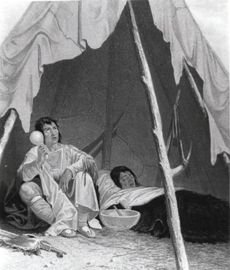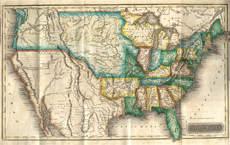Early United States Government Interest
in Native American Health
Although U.S. Army surgeons treated Native American victims of smallpox near the opening of the 19th-century, government concern for Native American health at this time was manifest more in counting the numbers of people who died from this and other diseases, and estimating how many were left, than in providing institutional remedies. Jedidiah Morse's report indicates this interest: Determining where "Indians" were in North America and how many they were. The report is addressed to the Secretary of War. Indian affairs were administered by the War Department until 1849.
The U.S. Government agreed to deliver regular provisions of food to many tribes, if they remained within certain restricted land areas. This food was often delivered months later than promised. Thomas Williamson's article tells that a late delivery of food to tribes of Dakotas resulted in the deaths of many. Williamson served as a medical missionary doctor at Lac qui Parle, Minnesota, from 1835 until 1846.
In 1849, the Office of Indian Affairs was transferred from the War Department to the then newly formed Department of the Interior. At this time, Native Americans were being interned on reservations, largely against their will. Reservation life for Native Americans meant increasing risk to disease, due to poor conditions. The administration of reservation health care became a major challenge for the Office of Indian Affairs and remained so throughout its tenure of Native American health care.
Exhibit Case 1

Medicine man administering to a patient
An engraving by Captain Samuel Eastman, U.S. Army, for an 1857 book by Henry Schoolcraft. (See below)

Jedidiah Morse, Report to the Secretary of War of the United States on Indian Affairs, Comprising a Narative of a Tour Performed in the Summer of 1820, Under a Commission from the President of the United States, for the Purpose of Ascertaining for the Use of the Government the Actual State of the Indian Tribes in our Country. 1822.
This map is probably by Morse, who is known as the "father of American Geography."
"Consummation of the Government Policy of Removal. Prevalence of the Small-Pox amongst the Western Indians. 1837. M. Van Buren, President. The Summer of 1837 is rendered memorable in Indian history by the visitation of one of those calamities which have so much reduced the Indian population, viz: the ravages of the small-pox, which then swept through the Missouri valley. The disease was introduced among them from a steamboat, which ascended that river from the city of St. Louis, in July. On the 15th of that month the disease made its appearance in the village of the Mandans, great numbers of whom fell victims to it. Thence it spread rapidly over the entire country, and tribe after tribe was decimated by it.
The Mandans, among whom the pestilence commenced, are stated to have been reduced from an estimated population of 1600 souls to 125. The Minnetarees, or Gros Ventres, out of a population of 1000 persons, lost one-half their number. The Arickarees, numbering 3000, were reduced by this pestilence to 1500. The Crows, or Upsarokas, lost great numbers, and the survivors saved themselves by a rapid retreat to the mountains. The Assinaboins, a people roughly estimated at 9000, were swept off by hundreds. The Crees, living in the same region, and numbering 3000 souls, suffered in an equal degree. The disease appears at length to have exhausted its virulence on the Blackfeet and Bloods, a numerous and powerful genus of tribes. One thousand lodges are reported to have been desolated, and left standing, without a solitary inhabitant, on the tracts and prairies, once the residence of this proud and warlike race: a sad memorial of this dreadful scourge.
Visitors to these regions, during the year when this dread pestilence was raging there, represent the Indian country as being truly desolate. Women and children were met wandering about without protection, or seated near the graves of their husbands and parents, uttering pitiable lamentations. Howling dogs roamed about, seeking their masters. It is reported that some of the Indians, after recovering from the disease, when they saw how it had disfigured their faces, threw themselves into the Missouri river.
Language, however forcible, fails to give an idea of the reality. On every side was desolation, and wrecks of mortality everywhere presented themselves to the view. Prominent among these was the tenantless wigwam: no longer did the curling smoke from its roof betoken a welcome, and its closed door gave sad evidence of the silence and darkness that reigned within. The prairie wolf sent up its dismal howl, as it preyed upon the decaying carcases; and the lonely traveller, as he rapidly passed through this scene of desolation and death, was frequently startled by the croaking of the raven, or the screams of the vulture and falcon, from trees or crags commanding a view of these funereal scenes."
Source: Henry Rowe Schoolcraft, History of the Indian Tribes of the United States: Their Present Condition and Prospects, and a Sketch of Their Ancient Status, 1857. Report of smallpox in 1837, pp. 486-7.
"As above mentioned, I moved to Kaposia, an Indian village sixmiles [sic] by the river below St. Paul, in the autumn of 1846. During the winter I was called to see several genuine cases of ague, and a much larger number of abnormal cases of paludal disease; and here I will state that this disease which used to be called bilious fever is much less regular in form in Minnesota than it was in Ohio when I practised there. Usually there is much less of what is called fever, that is of heat and arterial action and often the chill or sweating stage is scarcely perceptible; so that, though readily recognizable by persons familiar with it, even regular physicians who know it merely from description in books are very liable to mistake it from some other disease. Since I have ceased to practice medicine I have seen several instances of this, two of which proved fatal, as appeared to me, in consequence of this mistake. The summer of 1847 also was unusually warm and cases of paludal disease were numerous, both among whites and Indians in the country near Fort Snelling. The Dakotas suffered most because, like our British ancestors, for security against their enemies they made their villages in the midst of swamps, and also because they lacked food. Government usually gave them their flour and pork in the month of June, but that year it was withheld for a month or two, and many of them died in consequence. In health they could have subsisted on roots, chiefly of sagittaria, obtained from swamps, and on wild ducks, pigeons and fish. But the stomach of the sick rejected fish and pigeons; and it often happened that when a man, after wading in swamps for hours, returned with ducks, or a woman with roots, he or she would fall down in a chill. The food brought home was speedily prepared, but the bringer in a chill or fever was gone and appetite had returned some hungry child had eaten all the food.
I suppose a majority of the Indians were more or less affected with the disease, and about one in thirty died of it. Many more would have died but for food given them by their white neighbors, and probably four-fifths of those that died might have been saved by proper food and medicine. Subsequent summers were cooler, more healthy sites were selected for some of the villages the next year, and there was less of the disease, and subsequently but little.
Some years later these lower Sioux, as they were called, suffered severely from whooping cough in the spring and early summer. To the children who were brought to me soon after the attack I gave small doses of tartar emetic for the first two weeks, keeping their stomachs a little irritable so that when the cough came on severely they would vomit a little. Later in the disease when they became feverish or the stomach so irritable as to reject necessary food, I gave laxatives, and of those thus treated I think not one died. At other villages the mortality was considerable. I was taken to see the sick after more than twenty had died, out of a population of about 400. On examining the little sufferers it was manifest they were perishing for lack of nutriment; and on inquiry I found that the whole village had for some time been subsisting solely on fish, and whenever a paroxysm of coughing came on they vomited what had been eaten. Medicine could do but little for them, so I told the chief to call together his principal men, told them all to look at the sick children and gave them a severe scolding for letting the children starve. When they pleaded poverty as an excuse I told them to send all the young men immediately to hunt deer, and for the older ones to go to their traders and get corn, flour and sugar for the children. They did as I directed and very few died afterwards.
Similar treatment was less successful when the disease prevailed in winter, because it was impossible to keep the patient comfortably warm.
Yours truly,
THOS. S. WILLIAMSON."
Source: Thomas S. Williamson, "The Diseases of the Dakota Indians," Northwestern Medical and Surgical Journal Vol. 4, 1874, pp. 418-9.
Last Reviewed: March 5, 2024


